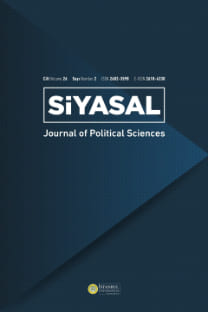Uluslararası Marka Strateji Formülasyonu: Standardizasyon ve Uyarlama Yaklaşımları
Bu çalışmanın amacı uluslararası marka stratejilerinin oluşum sürecini incelemek, bu süreci etkileyen faktörleri sınıflandırarak ortaya koymak ve standardizasyon ve uyarlama yaklaşımlarının bu süreçteki etkilerini ve sonuçlarını teorik çerçevede incelemektir. Çalışmada, marka stratejilerinin önemi belirtilerek, uluslararası marka stratejisi oluşturma adımları; marka tipolojileri ve uluslararasılaşma stratejilerinin belirlenmesi çerçevesinde incelenmektedir. Uluslararası marka stratejilerini etkileyen faktörler incelenerek, standardizasyon ve uyarlama yaklaşımlarının avantaj ve dezavantajları ortaya konmuştur. Çalışma, firmaların ve marka yöneticilerinin uluslararası markalar yaratma sürecinde göz önünde bulundurmaları gereken noktaları vurgulayarak son bulmaktadır.
International Branding Strategy Formulation: Standardization and Adaptation Approaches
The aim of this study is to examine the international branding strategy formulation process while classifying and revealing the factors influencing this process and analyzing the effects and results of standardization and adaptation approaches throughout this process. Primarily focusing on the significance of the branding strategies, international branding formulation stages are presented in terms ofbrand typology determination and brand internationalization strategies. Detailing the effectual factors on international branding strategies, the pros and cons of standardization and adaptation approaches are signposted. The study points out the crucial issues that should be taken into consideration by the firms and brand managers while formulating the international branding strategies within a theoretical structure.
___
- • Aaker, D.A.; Joachimsthaler, E. (1999). The Lure of Global Branding, Harvard Business Review, Nov-Dec, s.86-95.
- • Arnold, D. (2004). The Mirage of Global Markets “How Globalizing Companies Can Succeed as Markets Localize”, Pearson Education Inc.
- • Cateora, P.; Ghauri, P. (2005). International Marketing, Second European Edition, Mc Graw Hill.
- • De Mooji, M. (2005). Global Marketing and Advertising: Understanding Cultural Paradoxes, Second Edition, Sage Publications.
- • Douglas, S.P.; Craig, C.S.; Nijssen, E.J. (2001). Executive Insights: Integrating Branding Strategy Across Markets: Building International Brand Architecture. Journal of International Marketing, 9(2), s.97-114.
- • Erdil, S.; Gegez, A.E. (2005). From Standardized Global Marketing to Global One to One Marketing: A Demand Oriented Transition. Oneri, Marmara Universitesi Sosyal Bilimler Enstitüsü Hakemli Dergisi, 6(23), s.47-53.
- • Hollensen, S. (2004). Global Marketing, A Decision-oriented Approach, Prentice Hall, Third Edition.
- • Holt, D.B.; Quelch, J.A.; Taylor, E.L. (2004). How Global Brands Compete, Harvard Busines Review, September, s.69-75.
- • Keller, K.L. (2003). Strategic Brand Management, Building, Measuring and Managing Brand Equity, Prentice Hall.
- • Kotler, P.; Armstrong, S. (1999). Principles of Marketing. Second European Edition, Prentice Hall Europe.
- • Kumar, N. (2003). Kill A Brand Keep A Cusotmer. Harvard Business Review, December, s.86-95.
- • Laforet, S.; Saunders, J. (1994). Managing Brand Portfolios:
- • How The Leaders Do It. Journal of Advertising Resarch, Sep – Oct, s.64-76.
- • Levitt, T. (1983). Globalisation of Markets. Harvard Business Review, May-June, s.92-102.
- • Matthiesen, I.; Phau, I. (2004). The Hugo Boss Connection: Achieving Global Brand Consistency Across Countries. Brand Management, 12(5), s.325-338.
- • Olins, W. (1989). Corporate Identitiy. London, Thames and Hudson.
- • Plummer, J.T. (2000). How Personality Makes A Difference. Journal of Advertising Research, 40(6), s.79-83.
- • Porter, M. (1996). What is Strategy. Harvard Business Review, Nov-Dec,s.61-78.
- • Segal – Horn, S. (1996). The Limits of Global Strategy. Strategy and Leadership, 24(6), s.12-17.
- • Solberg, C.A. (2000). Educator Insights: Standardization or Adaptation of the International Marketing Mix: The Role of the Local Subsidiary/Representative. Journal of International Marketing, 8(1), s.78-98.
- • Subramaniam, M; Hewett, K. (2004). Balancing Standardization and Adaptation for Product Performance in International Markets: Testing the Influence of Headquarters – Subsidiary Contact and Cooperation. Management International Review, 44(2), s.171-194.
- • Theodosiou, M.; Leonidou, L.C. (2003). Standardization versus Adaptation of International Marketing Strategy: An Integrative Assesment of the Empirical Research, International Business Review, 12, s.141-171.
- • Van, W. (1994). Aspects of Business in a Global Market. European Business Journal, 6(2), s.28-32.
- ISSN: 1303-1260
- Yayın Aralığı: Yılda 2 Sayı
- Yayıncı: İstanbul Üniversitesi
Sayıdaki Diğer Makaleler
İkiz Açıklar Olgusu: Frekans Alanında Nedensellik Yaklaşımı
Gülsün YAY GÜRKAN, Hüseyin TAŞTAN
Rawls'ın Adalet Teorisi ya da Biçimsel Hak Anlayışının Teorik Açmazları Üzerine
Küresel Emisyon Ticareti Sistemi İçin Bir Model: Avrupa Birliği Emisyon ticareti Programı
Osmanlı İmparatorluğunun Borçlanmasında Yabancı Sermayenin Etkisi
Uluslararası Marka Strateji Formülasyonu: Standardizasyon ve Uyarlama Yaklaşımları
